Mark Sisson's Blog, page 93
October 9, 2019
23 Fall Salad Recipes
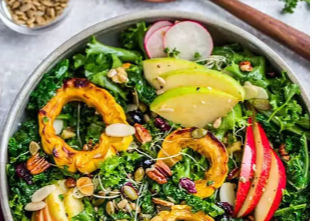
A special thanks to Aimee McNew at Paleohacks.com for today’s Whole30® recipe roundup.
Autumn is abundant with hearty and savory foods, but that doesn’t mean salad season has to be over.
The best thing about autumn salads? You can get a bowlful of plentiful veggies in hearty mixes that often work better as the main dish, rather than a skimpy side!
These 23 Paleo recipes for fall salads are filled with seasonal flavors like pumpkin, apples, pecans, and warm herbs and spices like ginger and nutmeg. Then, you’ll drizzle everything in warm dressings with autumn ingredients like sweet maple syrup and tangy apple cider vinegar!
These naturally one-pot salads come together quickly and easily, so you can enjoy them for quick weeknight dinners or prep them for lunches the night before work or school.
Warning: You’re going to want to try every single one of these bountiful salads!
1. Autumn Spinach Salad
This simple, savory salad pairs classics like chicken, bacon, and apples and drizzles it in a sweet and salty maple dressing.
Autumn Spinach Salad | PaleoPlan
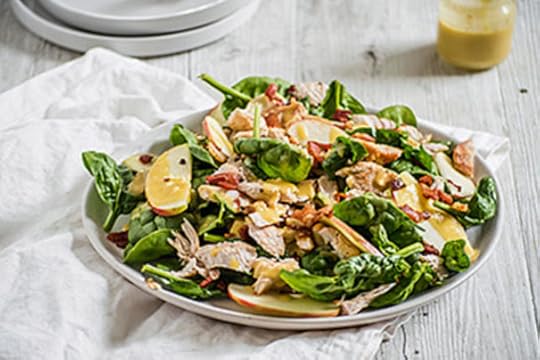
2. Paleo Fall Salad with Butternut Squash, Bacon, and Kale
Hearty greens like kale and bok choy shine in this fall salad that combines the sweetness of roasted squash with salty bacon.
Paleo Fall Salad with Butternut Squash, Bacon, and Kale | Bulletproof

3. Spicy Roasted Cauliflower, Kale, and Carrot Salad
If you’re not craving a lot of leafy greens these days, listen up: This warm and spicy salad made with roasted cauliflower, sweet carrots, and pumpkin seeds is about to become your new favorite.
Spicy Roasted Cauliflower, Kale, and Carrot Salad | PaleoHacks

4. Fall Vegetable Salad
Warm toasted almonds and a homemade sun-dried tomato dressing transform the simple flavors of spinach, parsnips, and squash into a dish bursting with autumnal zest.
Fall Vegetable Salad | Paleo Leap

5. Fall Harvest Chopped Salad with Apple Maple Vinaigrette
Want to sneak in your veggies? Squash, bacon, cranberries, and pecans are drizzled in a sweet apple vinaigrette for a salad that’ll make you forget you’re eating healthy.
Fall Harvest Chopped Salad with Apple Maple Vinaigrette | PaleOMG

6. Kale Salad with Caramelized Butternut Squash and Honey-Balsamic Dressing
Watch out—this beautifully vibrant salad just might take center stage at your Thanksgiving table this year. Bright kale mixes with caramelized squash and is studded with sweet pomegranate seeds for a striking color contrast.
Kale Salad with Caramelized Butternut Squash and Honey-Balsamic Dressing | PaleoHacks

7. Poached Pear and Prosciutto Salad
Sweet Bosc pears simmer in an aromatic vanilla cranberry broth, then are sliced and served with figs, cranberries, and smoked meat for the ultimate sweet-savory seasonal salad.
Poached Pear and Prosciutto Salad | Plaid and Paleo
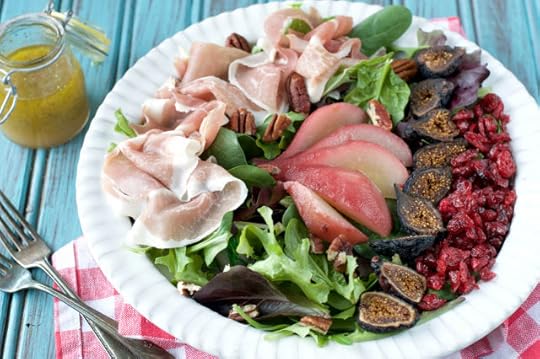
8. Fall Harvest Salad with Creamy Pumpkin Dressing
If you wait all year to be able to eat pumpkin-everything, this salad will be your new BFF. This salad of squash and mixed greens is drizzled with the perfect creamy pumpkin dressing, then topped with toasted pumpkin seeds.
Fall Harvest Salad with Creamy Pumpkin Dressing | Fed and Fulfilled
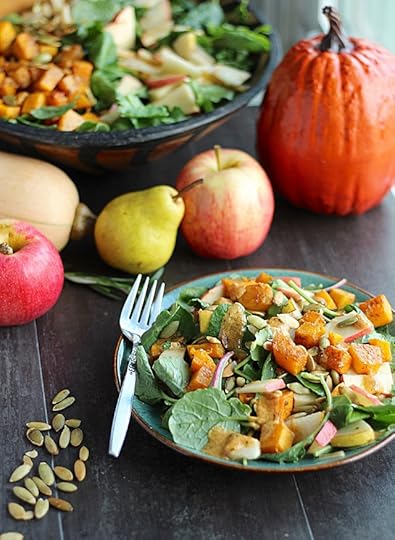
9. Butternut Squash Kale Salad with Juicy Pomegranate Seeds
Bacon, almonds, and onions play a supporting role in this hearty kale mix. Top it with a tangy red wine vinegar dressing for a dinner-worthy salad!
Butternut Squash Kale Salad with Juicy Pomegranate Seeds | PaleoHacks

10. The Ultimate Fall Salad
Red cabbage, pomegranates, and Brussels sprouts set the stage for this gorgeous pecan-topped fall salad. Just be sure to leave out the optional Parmesan for a truly Paleo-friendly dish!
The Ultimate Fall Salad | Making Thyme for Health

11. Fall Chopped Salad
Apples, pecans, and cranberries come together in a salad blend full of fall abundance. The honey-mustard dressing alone is worth its weight in, well, creamy gold perfection.
Fall Chopped Salad | One Lovely Life

12. Beetroot and Pumpkin Salad with Oregano Garlic Chicken
The earthy flavor of beets are tamed by sweet and savory pumpkin, then brought to the next level with juicy garlic chicken thighs. It’s the genius fall combination you’ll wish you thought of first!
Beetroot and Pumpkin Salad with Oregano Garlic Chicken | Irena Macri
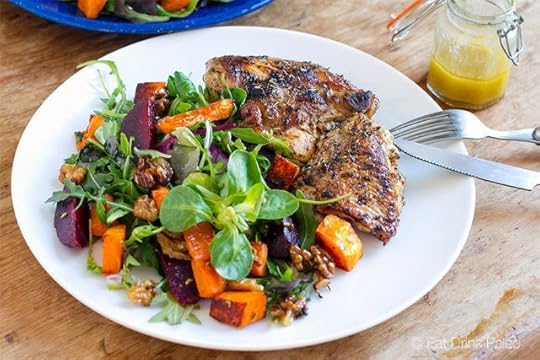
13. Caramelized Roasted Fig Spinach Salad
You’ll be coming back for seconds when you taste this warming spinach salad drizzled with an addictively toasty pecan vinaigrette.
Caramelized Roasted Fig Spinach Salad | Get Inspired Everyday

14. Roasted Delicata Squash, Pear, and Pomegranate Salad
No boring salad to be found here. Sweet squash and peppery arugula add a gourmet flair to this seasonal dish, while a maple balsamic dressing keeps things tangy and exciting.
Roasted Delicata Squash, Pear, and Pomegranate Salad | Downshiftology

15. Radicchio Salad with Caramelized Carrots and Onions
The sweetness of oranges plays nicely with the slight bitterness of radicchio. It’s a delightful blend of colors and textures with true simplicity at its core.
Radicchio Salad with Caramelized Carrots and Onions | Epicurious

16. Harvest Fall Salad
This harvest salad is packed with a smorgasbord of seasonal delights, like pumpkin, endive, apple, pear, pecans, and cranberries. Plus, it’s fully customizable for dietary preferences like keto and Whole30®—or for whatever ingredients you have on hand.
Harvest Fall Salad | Life Made Sweeter

17. Chicory Salad with Honey-Mustard Vinaigrette
Hearty, bitter greens like escarole, radicchio, and chives are dressed up with a vinegar-mustard dressing and toasted pecans. Swap in whatever greens you have on hand as needed!
Chicory Salad with Honey-Mustard Vinaigrette | Epicurious
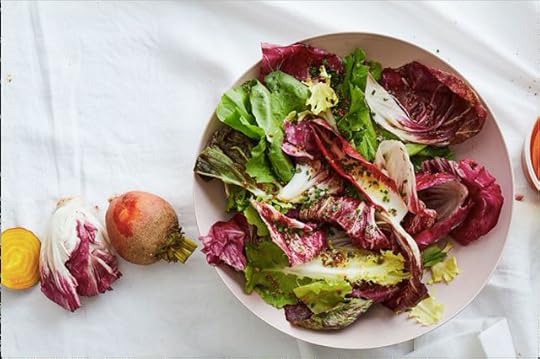
18. Fall Bliss Salad with Cinnamon-Cider Vinaigrette
You can have this gorgeous side salad on your table in under 30 minutes. It’s fancy enough for the holidays, but satisfying enough for any day of the week.
Fall Bliss Salad with Cinnamon-Cider Vinaigrette | Paleo Scaleo

19. Roasted Sweet Potato Salad with Cranberry Vinaigrette
Prep this hearty chicken salad ahead of time, then bring it to work and drizzle on the sweet and zingy orange cranberry dressing just before digging in. Your coworkers will be green with envy!
Roasted Sweet Potato Salad with Cranberry Vinaigrette | Real Simple Good

20. Marinated Mushroom and Charred Broccolini Salad
Your favorite seasonal mushrooms, fennel, and broccolini are jazzed up in a zesty lemon dressing for Paleo salad that also happens to be vegan- and Whole30-friendly.
Marinated Mushroom and Charred Broccolini Salad | Country Living

21. Sweet Potato, Apple, and Avocado Salad
Go vegetarian with this low-carb yet satisfyingly chunky fall salad.
Sweet Potato, Apple, and Avocado Salad | Savory Simple

22. Autumn Arugula Salad with Caramelized Squash and Pomegranate Ginger Vinaigrette
Take this abundant autumn salad to the next level when you season the squash with a dash of—what else?—pumpkin spice. Just be sure to swap the brown sugar for coconut sugar to keep it fully Paleo!
Autumn Arugula Salad with Caramelized Squash and Pomegranate Ginger Vinaigrette | How Sweet Eats

23. Green Apple and Cranberry Chicken Salad
Serve this crunchy chicken salad over a bed of leafy greens for a veggie-packed, protein-fueled lunch.
Green Apple and Cranberry Chicken Salad | Tastes Lovely

Thanks again to Aimee McNew from Paleohacks.com. Interested in seeing a certain recipe or roundup of a certain category—Primal, Primal-keto or other? Let us know below!

The post 23 Fall Salad Recipes appeared first on Mark's Daily Apple.



October 8, 2019
Mark’s Favorite Exercise: Trap-Bar Deadlift
 As you might have noticed, I’ve been doing more mini-videos about my daily routines, training regimens, and other thoughts on health. After some initial trepidation and a lot of demand from readers, I find I actually really enjoy doing them. They’re a great way to get a quick take on a topic and give a visual representation of all this stuff I talk about on the blog. They don’t take that long to make. People like them, find them helpful. It’s actually the perfect medium to complement my writing.
As you might have noticed, I’ve been doing more mini-videos about my daily routines, training regimens, and other thoughts on health. After some initial trepidation and a lot of demand from readers, I find I actually really enjoy doing them. They’re a great way to get a quick take on a topic and give a visual representation of all this stuff I talk about on the blog. They don’t take that long to make. People like them, find them helpful. It’s actually the perfect medium to complement my writing.
In the past, I’ve done videos on a broad range of topics: active workstations, standup paddling, Ultimate Frisbee, the evolution of my fitness routine and outlook, microworkouts, slacklining, and my coffee routine. Today, I’m showing a video about my favorite exercise: the trap-bar deadlift.
Why Do I Love the Trap-Bar (AKA Hex Bar) Deadlift?
It’s a good balance between quads, hip flexors, hamstrings, and glutes—the anterior and posterior chain, in other words. And, you can accentuate each muscle group by making slight variations with your technique.
You can do them with more knee flexion bias—this hits the quads a bit more.
You can do them with posterior bias, keeping your knees straighter—this hits the glutes and hams better.
You can do both in one workout. First one bias, then the other.
You can increase the weight and use the higher grips, allowing you to increase the intensity and shorten the range of motion for safety.
You can decrease the weight and use the lower grips, giving you a deep range of motion.
You can stack weights and stand on them inside the trap bar, giving you an even deeper range of motion. Stack them high enough, and you can turn the lift into a near-squat.
That’s a ton of variation and customization with just one basic movement.
And if I’m feeling like doing some other stuff, it’s right there ready to go. I can do farmer’s walks with the trap bar. Load it up, pick it up, and walk around under load.
I can do bent-over trap bar rows.
I can do shoulder shrugs. Sometimes I’ll even combine the deadlift with the shrug: lift it up, shrug at the top, repeat.
Most of all, the trap-bar feels comfortable in my hands. It feels right when I lift it. It feels like exercise should feel: like I’m stressing my body but not endangering it.
How I Do It
Check out how I do my deadlift session and how I use the handle options for different weight loads.
?
It’s safe to say the trap-bar is going to be in my arsenal for life. I suggest you get yourself one, or try it out the next time you hit the gym.
What’s your favorite exercise? Have you tried the trap-bar? What’d you think? Got any other trap-bar exercise variations you’d recommend?
Take care, everyone, and thanks for reading.

The post Mark’s Favorite Exercise: Trap-Bar Deadlift appeared first on Mark's Daily Apple.



October 7, 2019
The Health Scare That Changed My Life
It’s Monday, everyone! And that means another Primal Blueprint Real Life Story from a Mark’s Daily Apple reader. If you have your own success story and would like to share it with me and the Mark’s Daily Apple community please contact me here. I’ll continue to publish these each Monday as long as they keep coming in. Thank you for reading!

Yup, success stories are back! And I’m looking for more. Follow-ups, mid-progress reflections—every story at every stage has the potential to inspire folks out there who are getting started or contemplating a new beginning. Contact me here to share your story—long or not so long. You never know who you’ll impact by doing it. Enjoy, everyone!
As a lifelong martial artist and owner-operator of a martial arts school for 8 years, I’ve spent the majority of my adult life training or in the gym. I have always worked to have a healthy, active lifestyle, attempting to manage weight and conditioning through high intensity training while following the Standard American Diet (SAD).
For many years, I supplemented my martial arts training with running or cycling long distances at high intensity. I remember feeling that if I didn’t work hard there would be no benefits. I worked out so I could eat whatever I wanted without the concern of gaining weight. I was oblivious to any related health risks.
This produced a highly stressful, chronic cardio lifestyle with poor dietary and lifestyle practices. Not to mention, as I aged, the weight gain came regardless of the amount of exercise I did. My weight gain was not excessive by most conventional standards, but I could never recapture my previous results, and the training became progressively harder as I aged.
During that time, I witnessed my high blood pressure increase, and to my ultimate surprise, learned I had cancer.
I was diagnosed in August 2013 with bladder cancer, and was devastated to find I had a tumor. I truly believed my lifestyle was healthy. Being a father of two young daughters, I wanted to be a good role model for them and be there throughout their lives. I could not get my head around the fact that, although I was doing what I’d always been taught was healthy, I actually wasn’t. At that time, I had no idea the impact my stressful eating and training regimen was having on my body.
The cancer was successfully treated through surgery, but I wanted to ensure it didn’t come back. I also wanted to finally deal with the blood pressure concern that had been with me for years.
I started to “eat healthier” with a renewed focus on eating throughout the day, consuming plenty of fruits and whole grain foods, reduced fats, and replacing animal fats with recommended processed vegetable oils. I even took supplements I thought would help my general health. Regardless of my best efforts, my weight continued to increase and my energy plummeted. I remember routinely coming home after work, planning to train but needing to nap first.
I was frustrated that the dietary and exercise advice I was following was not helping.
While I had stopped running when I found out I had cancer, I began again in 2015—this time with much less intensity regarding pace and distance. I intuitively felt it would be better to follow a moderate training schedule, but did not have the information or education to help me at that time.
For over a year, I ran almost every day at a lower intensity and generally for a shorter distance. I felt pretty good during that phase, however my weight started creeping up again. I had settled into a pattern of keeping “fit,” but my efforts to manage my weight—and my overall health—were failing.
My Introduction to Primal Health
In February 2017, a college friend suggested that I listen to the Primal Endurance podcast featuring the Maximum Aerobic Function (MAF) system of cardio training.
I listened, and listened and listened. From that point forward, I started learning as much as I could about Primal living. In fact, I’ve listened to Brad Kearns so much that his voice and Mark Sisson’s message have become imprinted in my DNA…lol.
I immediately reduced carbs by eliminating all sugars and grains, and quickly worked to eliminate refined oils—helping me become fat- and keto-adapted.
I also modified my training to stay within my maximum aerobic function heart rate for almost all of my runs, and reduced my training to allow for more rest and recovery.
In August 2017, I went to my doctor for my annual physical and full blood work. I had lost 30 pounds since I saw him last. My blood markers were excellent, too, and I did not need to continue blood pressure medication.
I continued to devote as much time as I could to learning about primal living and ancestral health, and in February 2018, I enrolled in the Primal Health Coach Institute program—earning my certification in just 6 months!
I entered into my primal journey to overcome my own health concerns, and to better understand what I need to do to improve my overall health and longevity. And all of my expectations have been exceeded!
What I’ve Done Since Getting Certified…
I have been building my health coaching business organically, while continuing on with my current career. My enthusiasm grows as I work through the processes of building and maintaining my coaching business website and blog, having an active social media presence, and working with my employer to promote health and wellness for our employees.
As I move toward my retirement years, I reflect on a time when I was excited about reducing my responsibilities and taking it easy. But now that I am “aging backwards,” I am excited about something totally different—filling those years working as a Primal Health Coach.
Since starting my Primal Health Coach journey, my intent has always been to be a resource for lifelong positive health changes for my clients, family, friends, and colleagues. I hope to inspire, encourage, and educate as many people as possible, regardless of age or perceived limitations.
I am an example that you can take charge of your health and longevity and win!
— Vern Gorman
Primal Health Coach Institute Directory listing

Have a story to share? Email me here. Thanks, everybody, and have a great week.

The post The Health Scare That Changed My Life appeared first on Mark's Daily Apple.



October 6, 2019
Primal (or) Keto Fudgy Brownies
 Keto eating should always put nutrients first, but there’s nothing wrong with having treat recipes on hand for when you’re making the conscious choice to enjoy something sweet. This recipe offers it all—whole food, Primal friendly ingredients for whipping up either a Primal brownie batch…or a keto version. You’ll enjoy the rich texture and deep chocolate taste without the typical sugar rush.
Keto eating should always put nutrients first, but there’s nothing wrong with having treat recipes on hand for when you’re making the conscious choice to enjoy something sweet. This recipe offers it all—whole food, Primal friendly ingredients for whipping up either a Primal brownie batch…or a keto version. You’ll enjoy the rich texture and deep chocolate taste without the typical sugar rush.
Tips: This recipe has a primal option sweetened with dates and a keto option sweetened with a granulated monk fruit sweetener. Feel free to use Swerve in lieu of the monk fruit. These brownies are extra fudgy and taste even better after being refrigerated, so we highly recommend allowing them to cool, cutting them and then placing them in the fridge for a few hours or overnight before enjoying.
Servings: 12 Brownies
Prep Time: 15 minutes
Cooking Time: 20 minutes
Ingredients:
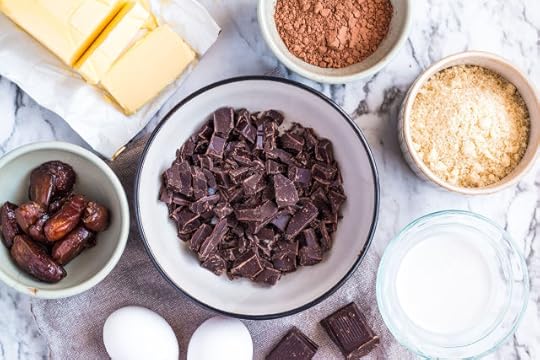
Primal Brownies Ingredients:
¼ cup Salted Butter
3.5 oz. (100g) 70% Chocolate, chopped
1/4 cup Full Fat Coconut Milk
10 Dates, soaked (we used Deglet Nour dates)
1 tsp. Vanilla Extract
1/2 cup Almond Flour
5 Tbsp. Cacao Powder
Pinch of Espresso Powder, optional
2 Large Eggs
Keto Brownies Ingredients:
5 Tbsp. Salted Butter
3.5 oz. (100g) 85% Chocolate, chopped
5 Tbsp. Cacao Powder
1/2 cup Almond Flour
¼ cup Granulated Monk Fruit Sweetener or Swerve
5 Tbsp. Coconut Milk
1 tsp. Vanilla Extract
Pinch of Espresso Powder, optional
2 Large Eggs
Instructions:

Primal Option:
Preheat your oven to 350 degrees Fahrenheit.
Set up a double boiler by filling a pot with a few inches of water and placing it over medium heat. Once it begins to boil, reduce to a simmer and place a heat-safe bowl on top of the pot. Add the chopped chocolate and butter to the bowl and gently mix using a spatula until the mixture is melted.
Soak the dates in hot water for at least 10 minutes. Drain the dates and add the dates, coconut milk and vanilla extract to a food processor. Blend until the mixture is fairly smooth, making sure to stop the processor occasionally to scrape down the sides. Add the chocolate and butter mixture and pulse a few more times. Add the almond flour, cocoa powder and espresso powder and pulse until combined. Add the eggs and blend until smooth.
Pour the brownie batter into a greased or parchment lined baking dish (the one we used was about 7”x7” but made fairly thick brownies, so you can also use a larger dish). Feel free to top with chopped chocolate or walnuts. Bake for approximately 20 minutes, or until the center is fairly firm. Allow the brownies to fully cool before slicing.

Keto Option:
Preheat your oven to 350 degrees Fahrenheit.
Set up a double boiler by filling a pot with a few inches of water and placing it over medium heat. Once it begins to boil, reduce to a simmer and place a heat-safe bowl on top of the pot. Add the chopped chocolate and butter to the bowl and gently mix using a spatula until the mixture is melted. Remove the bowl from the heat.
To the bowl, whisk in the monkfruit sweetener, and sift in the almond flour and cocoa powder. Add the coconut milk, vanilla extract and espresso powder. Whisk the eggs in a small bowl and fold them into the brownie batter.
Pour the brownie batter into a greased or parchment lined baking dish (the one we used was about 7”x7” but made fairly thick brownies, so you can also use a larger dish). Feel free to top with chopped chocolate or walnuts. Bake for approximately 18-20 minutes, or until the center is fairly firm. Allow the brownies to fully cool before slicing.
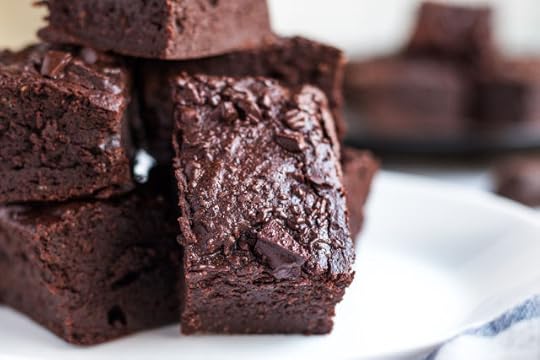
Primal Brownie Nutrition Information (1/12 of pan):
Calories: 159
Total Carbs: 10 grams
Net Carbs: 8 grams
Fat: 12 grams
Protein: 3 grams
Keto Brownie Nutrition Information (1/12 of pan):
Calories: 149
Total Carbs: 5 grams
Net Carbs: 2 grams
Fat: 13 grams
Protein: 4 grams


The post Primal (or) Keto Fudgy Brownies appeared first on Mark's Daily Apple.



October 4, 2019
Weekly Link Love — Edition 49
 Research of the Week
Research of the WeekDespite being at an increased risk of obesity, diabetes, and metabolic syndrome, shift workers eat the same number of calories as daytime workers.
In prehistoric Bavaria, babies were drinking animal milk out of clay bottles.
Eating eggs and dairy can’t save the B12 levels of vegetarians.
The monetary value of prayer (or not praying).
Dairy fat is vindicated once again.
Pretty much just humans and a few great apes can recognize themselves in the mirror.
New Primal Blueprint Podcasts

Episode 378: Shawn Wells: Host Elle Russ chats with Shawn Wells, a Registered Dietitian, Certified Sports Nutritionist, and Fellow in the international Society of Sports Nutrition who practiced over a decade as a Chief Clinical Dietitian in acute (hospital) and skilled nursing settings.

Episode 379: Sean Jewell—All About Dark Chocolate: Host Brad Kearns chats with chocolate expert Sean Jewell about choosing the best stuff and avoiding the bad.

Primal Health Coach Radio, Episode 28: Laura and Erin chat with Dr. Greg Kelly about supporting the brain with nutrition, nootropics, and lifestyle.
Each week, select Mark’s Daily Apple blog posts are prepared as Primal Blueprint Podcasts. Need to catch up on reading, but don’t have the time? Prefer to listen to articles while on the go? Check out the new blog post podcasts below, and subscribe to the Primal Blueprint Podcast here so you never miss an episode.
Media, Schmedia
The U.S. and U.K. are the only two non-developing countries with a falling life expectancy.
A new method may allow us to read damaged scrolls found in the ruins of Mt. Vesuvius. Can’t wait for Homer’s lost rom-com.
Interesting Blog Posts
A way to weigh a whale without a scale.
11 reasons why this trained dietitian is “Team Meat.”
Social Notes
Everything Else
Meet the energy efficient washing machine which acted as a drug-resistant pathogen reservoir in one German hospital.
Wild children allowed to be wild in nature will come to know, and love, the world.
A stone fridge for meat from 23,000 BC.
Things I’m Up to and Interested In
I, too, cannot deny reality: Experts are realizing that “eat less red meat” was actually bad advice.
News I enjoyed: Peter of Hyperlipid goes (mostly) carnivore.
Article I found interesting: The persistent myth of persistent hunting.
I’ll take these “secondary outcomes,” thank you very much: Vitamin C infusions fail to reduce organ failure score or inflammatory biomarkers in sepsis patients, but they do reduce mortality.
Nice essay: Meat is not the environmental problem you think it is.
Question I’m Asking
Will the health authorities ever accept the fact that red meat and high-fat dairy aren’t killing us?
Recipe Corner
Chinese chicken wings: sometimes you just want to gnaw on a bird wing.
Spaghetti squash ramen is quite genius.
Time Capsule
One year ago (Sep 29 – Oct 4)
How to Deadlift – Good to know.
Keto Compared: Analyzing Keto Against Popular Diet Trends – How keto measures up.
Comment of the Week
“The teen athlete using a high carb diet is plagued with significant increase in dental caries
As a practicing dentist for 47 years, I am stunned by the rapid increase in caries in the otherwise ‘healthy’ teen due to the large increase in refined carbs now encouraged in their sports diets
Dr John G Steuterman
Saint Louis Missouri”
– Important point, Dr. Steuterman. Thank you.

The post Weekly Link Love — Edition 49 appeared first on Mark's Daily Apple.



October 3, 2019
HIIT vs. HIRT: Reducing Workout Stress To Increase Fitness
 The fitness world is booming these days. You can see it in the popularity of CrossFit boxes, obstacle course and endurance events, and record-breaking gym construction. It’s encouraging. Inspiring even. But there’s also a downside to the rising gym memberships and event registrations. There are still too many people dealing with recurring patterns of breakdown, burnout, illness and injury. More people are trying to do the right thing, but the flawed approaches they often gravitate to end up derailing them.
The fitness world is booming these days. You can see it in the popularity of CrossFit boxes, obstacle course and endurance events, and record-breaking gym construction. It’s encouraging. Inspiring even. But there’s also a downside to the rising gym memberships and event registrations. There are still too many people dealing with recurring patterns of breakdown, burnout, illness and injury. More people are trying to do the right thing, but the flawed approaches they often gravitate to end up derailing them.
Nonetheless, there are changes afoot. It’s an evolution of thinking that’s slowly spreading its way through fitness circles. More forward-thinking coaches, trainers, and researchers are helping right the wrongs of the fitness boom with a general rejection of the “more is better” approach for one that respects the importance of balancing stress and rest, one that moves toward an intuitive approach to workout planning.
More people are implementing strategies to maximize workout return on investment and minimize the risk of injury and burnout that too often result from an indiscriminate approach. The endurance world, for example, is finally rejecting the narrowly focused, overly stressful chronic cardio approach of old in favor of emphasizing aerobic development at lower heart rates, avoiding chronic patterns, and becoming fat adapted instead of sugar addicted. Endurance athletes are embracing the importance of strength training and explosive sprinting just as strength/power athletes are doing more aerobic conditioning. The CrossFit movement itself is an ode to the health and longevity benefits and increased enjoyment that comes from achieving broader fitness competency.
What’s Wrong With HIIT?
I’ve talked recently about microworkouts and recovery-based workouts. Today, I want to delve in further and share a radical transformation in the way high intensity workouts are conducted that will generate fitness breakthroughs while simultaneously minimizing the risk of exhaustion. Specifically, I’m taking aim at the extremely popular workout pattern known as HIIT—High Intensity Interval Training. Sprinting is a part of the Primal Blueprint Fitness Pyramid, but I’ve been wary of the details around traditional HIIT practices because these workouts are quite often too stressful and exhausting to deliver the intended fitness boost they promise.
Yes, you have to challenge your body regularly with hard efforts to build fitness, but most of us do it the wrong way. When you complete a killer HIIT session at morning boot camp or spin class, at home on your Peloton bike, or with the Tuesday night track group, you get a tremendous sense of accomplishment and a flood of feel-good endorphin chemicals into your bloodstream. Unfortunately, the typical HIIT workout can also be depleting, exhausting, and stimulate an assortment of unnecessary cellular damage and inflammation.
It doesn’t have to be that way. Be redesigning your high intensity workouts, you can get leaner and fitter with higher quality, more explosive, less physically stressful workouts that are easier to recover from and thus can be performed more frequently. In short, a better approach involves transitioning from HIIT to HIRT, High Intensity Repeat Training. HIRT is an acronym coined by Dr. Craig Marker, psychologist, certified strength and conditioning coach, and CrossFit instructor from Florida.
Here’s a compare and contrast that can revolutionize your approach to intense workouts….
Comparing HIIT and HIRT
The problem with a typical HIIT workout is that it’s too strenuous—too many repetitions of hard effort that (each) last too long, and with insufficient rest between hard efforts. This results in cumulative fatigue during the workout, a diminishing quality of performance over the course of the workout, increased cellular damage due to this cumulative fatigue, and extended recovery time afterward. These kinds of sufferfests are a great source of satisfaction and personal growth when you high five your fellow bootcamp classmates after an hour of power, or cross the finish line of a big event in which you’ve trained for months to prepare. But including them as a major and recurring element of your training program is a really bad idea. Unfortunately, the sufferfest mindset is incredibly common these days, perhaps suggesting that the ego has more influence that strategic planning or intuitive decision making.
A HIRT workout stops short of the exhaustive nature of HIIT. The essence of HIRT is to conduct maximum efforts, typically of shorter duration, with much longer recovery, and fewer total efforts than a HIIT session. The word “Repeat” in the acronym suggests that you maintain a consistent quality of effort on every repetition of hard work. This means not only the same performance standard, but also the same level of perceived exertion.
For example, say your workout entails running 100-meter sprints across a football field, and you hit 18 seconds for your first sprint. This is a nice controlled, explosive effort with excellent technique, and you assign a perceived exertion level of around 90 out of 100. Hence, you’ll want to do successive sprints in 18-19 seconds each, preserving explosiveness and excellent technique—delivering what you still discern to be 90 out of 100 on the effort scale. If you have to “dig deep” (the implicit objective, and badge of honor, with a HIIT session) just to arrive at 19 seconds on your fourth effort, that’s it, you’re done. If you notice a slight attrition in explosiveness or breaking form during the effort, you’re done. Typically, this might be a little twinge in the hamstrings or lower back, a tensing of the face or chest, or any other indicator that you have played your best cards of the day.
In Dr. Marker’s landmark article titled “HIIT versus HIRT” at www.BreakingMuscle.com, he explains that after HIIT sessions we bask in self-satisfaction of a job well-done, but disregard the health-destructive consequences of these sufferfests: “[Y]our subjective feeling of the effectiveness of a workout is not as important as what science tells us is important to building an impressive base of endurance and changing your body composition.” (That sound you hear is a slap to the face of highly motivated, goal oriented, Type-A fitness enthusiasts across the land. Don’t worry, I’ve been there, too….)
This admonition applies to everyone from elites to novices. Elite athletes are notorious for constantly pushing the envelope and frequently succumbing to injuries or periods of declining performances. Novices generally don’t concern themselves with training strategies, often leaving their fates in the hands of the bootcamp instructor. Without sufficient experience or reference points, they exercise themselves into exhaustion, believing that pain and suffering are part and parcel of the fitness experience.
The (too often) result? Ambitious, well-meaning enthusiasts burn themselves out and then are down for the count. The most dedicated keep going to their detriment, all the while accumulating fatigue, injuries and even pounds. Others simply stay away from the gym by invisible magnetic force. Alas, the subconscious is very good at avoiding sources of pain and suffering. Can we dump this suffering-and-attrition dynamic already?
Side note for those who love to read about sports: For inspiration, check out this article about the greatest marathon runner in the history of the planet, the amazing Kenyan Eulid Kipchoge. The article describes his training regimen as extremely devoted and incredibly impressive, yet he maintains a relaxed mindset, remains in control of his energy output, and never extends beyond his limits into exhaustion. Even the march to the unthinkable two-hour marathon (Kipchoge’s current world record stands at a mind-bending 2:01.39) comes from a sensible approach instead of an extreme one.
Marker explains that there’s an optimal duration for sprinting where you can obtain maximum benefits with minimal cellular destruction, and this is typically around 15-20 seconds. Try to maintain maximum effort for any longer than that and you’re not really sprinting anymore anyway, since it’s impossible to maintain maximum energy output.
Here’s why this works:
Look at what’s happening physiologically over the duration of a near-maximum intensity sprint of any kind (running, cycling, rowing, or kettlebell swings). During the first five seconds of your sprint, lactate starts to accumulate in the bloodstream. Lactate levels double between five to ten seconds, then double again from 10 seconds to 20 seconds—up to what Marker calls the highest acceptable level. As you increasingly feel the burn, lactate doubles again from 20 seconds to 30 seconds. It doubles again from 30 seconds to 60 seconds, causing cellular destruction, ammonia toxicity, and extended recovery time.
As Marker explains, “The amount of lactic acid produced up to 20 seconds [of sprinting] is still manageable, but the next doubling is over the top. Even a single 30-second sprint spikes ammonia levels almost five times! Why trash the body for no good reason? Rebuilding broken down cells is a costly and time-consuming process. And while it’s taking place, you feel tired and run down, with your ATP short of a full stack.”
You may be familiar with the Tabata concept of interval training, which entails a repeating pattern of work efforts lasting twice as long as rest intervals until you complete a Tabata set of a certain total duration. The original Tabata protocol, developed by Japanese physician and researcher Dr. Izumi Tabata and colleagues at the Japanese Institute of Fitness and Sport in Tokyo, calls for four minutes of a 20-second sprint, 10-second rest, 20-second sprint, 10-second rest pattern. In the original studies, Japanese Olympic speed skaters achieved massive boosts in VO2 Max in a short time with Tabata training. Unfortunately, the original Tabata concept has been widely misappropriated into workouts that honor the 2:1 work-to-rest ratio, but carry on for too long and generate cellular damage and exhaustion: multiple sets of kettlebell swings, pushups, box jumps, running sprints, cycling sprints, and so forth. Bottom line with sprint workouts: a little goes a long way, and too much can really mess you up.
How To Transition From HIIT To HIRT
To transition into a more effective, less stressful high intensity workout pattern, pick the sweet spot of 10-20 seconds for your explosive efforts. Take what Marker calls “luxurious” rest intervals to ensure that your cells have a chance to partially or fully regenerate ATP (takes around three minutes) and minimize the disassembling and deamination that occur when you ask your body to perform again and again with rapidly depleting cellular energy.
Finally, conduct between 4 and 10 sprints. You should be able to manage four shorts sprints even if you’re a novice. If you claim you can complete more than 10 and feel great, you’re better off going faster and doing fewer more explosively.
Keep in mind that a properly conducted HIRT workout is going to feel different than a HIIT sufferfest. It may require an adjustment in your mindset to feel confident and satisfied that you’re training with maximum efficiency and minimal suffering like a “real athlete.” If you’re a focused, driven, goal-oriented type, be vigilant about resisting the addictive allure of the endorphin rush that happens after a sufferfest. Remember, the blissful feeling of powerful pain-killing chemicals flooding your bloodstream is a fight or flight reaction to the extreme stress of the workout. Realize that the genetic purpose of the endorphin response is to help you continue to run for your life instead of lay down in exhaustion! If you abuse this delicate mechanism with a chronic pattern of extreme workouts, you’re going to pay a heavy price. Dr. Tommy Wood calls this overactivation of the fight or flight response, “liquidating your assets,” and I couldn’t agree more.
Several friends who have recently updated their approach to a HIRT protocol report feeling much better in the days following their most challenging sessions—more energy, less soreness and stiffness. That’s how it should be.
Combine the HIRT strategy with recovery-based workouts and walking. See how it goes for you, and let me know. Thanks for stopping in. Share your questions and thoughts below, too.

The post HIIT vs. HIRT: Reducing Workout Stress To Increase Fitness appeared first on Mark's Daily Apple.



October 2, 2019
Whey Protein vs. Pea Protein
 In response to the recent post on whey vs. collagen, a number of readers wrote in asking about pea protein. Today, I’m going to compare the two.
In response to the recent post on whey vs. collagen, a number of readers wrote in asking about pea protein. Today, I’m going to compare the two.
Before I begin, let’s get this out of the way: I’m biased toward whey protein. I sell the stuff. But the reason I sell whey protein is because I really like it, not the other way around. All my products are things that solved a problem I was having, an itch I needed to scratch. I made Primal Kitchen Mayo with avocado oil because I couldn’t find one without industrial seed oils and I didn’t want to make it fresh every time I wanted tuna salad. I put together Adaptogenic Calm (formerly Primal Calm) to help me and my buddies recover from heavy training. And so on. I made Primal Fuel out of whey protein isolate because it is the best gram-for-gram protein powder around. But pea protein is having its day in the sun now, and readers want the facts.
Common Arguments For Pea Protein
Is pea protein just as good as whey at building muscle?
Well, let’s take a look at the literature.
First of all, pea protein contains all 9 essential amino acids. That’s great.
Pea protein contains fewer branch chain amino acids—those amino acids that contribute most to muscle protein synthesis, but it does have them.
Pea protein is about 9% leucine, a very important amino acid for muscle building. Whey is 10-11% leucine, so pea comes pretty close.
In one study, resistance trained men and women in their 20s-40s were split into two groups. One group used pea protein. The other used whey protein. Both groups trained in the same manner (Crossfit-esque). At the end of 8 weeks they measured changes in muscle thickness, force production, and WOD (workout of the day) performance. Neither group had an advantage. Both groups gained about the same amount of muscle, performance, and force production.
In another study of resistance-training adults (men, aged 18-35), pea protein and whey protein resulted in similar bicep muscle gains.
That all looks pretty good for pea (and whey), but these were relatively young adults. As people age, the quality of the protein becomes ever more paramount. A young man or woman is hormonally primed for hypertrophy. Nature is working with them, not against them. If anything, they can actually get away with eating less protein than an older person of the same weight and still gain and maintain muscle because their ability to utilize dietary protein is optimized. Older people need more protein to do the same job because their ability to utilize dietary protein has degraded.
Not only do older people need high quantities of protein, they need high quality protein—bioavailable protein full of amino acids that promote muscle protein synthesis. Whey is simply higher quality on a biological level than pea protein. That difference may not show up as much in the younger person lifting and drinking protein shakes to increase their calories for mass gain, but it certainly shows up in the older person lifting and drinking protein shakes and trying to hold on to their lean mass.
Okay. You’re younger. You’re eating plenty of calories. You’re trying to gain weight. Your muscle protein synthesis capacities are optimal. You should, in theory, be fine with pea protein. Right? Sure, but why?
Pea protein is usually more expensive. It’s still technically lower quality than whey. The best justification for using pea protein to gain/maintain muscle is either you’ve got an uncle who works at a pea protein processing plant and can get you a great deal, or you’re vegan. That’s it.
All that said, pea protein looks to be the best plant-based protein around for performance in the gym. No arguments there.
What about high blood pressure? I’ve seen claims that pea protein can lower it.
Perhaps. In hypertensive rodents (probably working high stress jobs, enduring long commutes, and generally deep into the rat race), pea protein causes drastic reductions in high blood pressure, while the reductions are much more modest in humans taking pea protein daily for three weeks.
Whey does it too. In humans, a single dose of whey protein after a meal reduces postprandial blood pressure and improves arterial stiffness for up to 5 hours. It may just be the protein. Extra protein in general is great at lowering blood pressure, especially if you remove carbohydrates.
The (Relatively) Unique Strengths Of Whey Protein
The thing about protein powder is this—although whey gets most of its accolades on account of its effect on hypertrophy—gains, larger muscles, better performance, etc.—that’s not everything it can do. It also has some very unique health effects that other protein powders, most especially plant proteins like pea, do not possess.
Whey is anti-allergenic.
On the one hand, whey intolerance is the dairy protein intolerance with the lowest incidence. People are far more likely to be intolerant of or allergic to casein. But whey isn’t just less likely to be allergenic. It’s downright anti-allergenic. Whey-based formulas have shown efficacy in the prevention of allergic diseases like asthma and eczema in susceptible children and infants.
There’s no evidence that pea protein powder can do this.
Whey is anti-stress.
In “high-stress” subjects, a whey protein shake improved cognitive function and performance by increasing serotonin levels. The same shake had no effect on “low-stress” subjects. And dietary whey also lowers oxidative brain stress, at least in mice.
Pea protein may do this, but I haven’t seen the research.
Whey boosts antioxidant capacity.
Whey protein is one of the best foods we know that increase levels of glutathione—the body’s master antioxidant. We use glutathione to detoxify the liver, to metabolize alcohol and other toxic substances, to control allergic reactions, to recycle and restore to active status vitamins and antioxidants, to quell free radicals, and to perform many other vital processes.
There is simply no evidence that pea protein has the same effect. It doesn’t have enough cysteine.
Whey transforms when you digest it.
Once the whey protein hits your GI tract, many different bioactive peptides with their own unique effects are formed. In a recent review (PDF), a team of Polish researchers explored the effects of at least nine of these whey-derived peptides. Some improve blood lipids, lower blood pressure, or act as opioid receptor agonists (if you’ve ever seen a milk-drunk baby bliss out after nursing, his opioid receptors are likely being severely agonized by bioactive peptides). Others induce satiety and improve metabolic health biomarkers.
I’m sure other proteins change when digested, but their effects haven’t been studied as closely as whey.
Bioactive Components In Whey (But Not Pea Protein)
There are also a number of bioactive components in whey protein that are not in pea protein:
Beta-lactoglobulin
Promotes glutathione synthesis and reduces allergic disease incidence.
Improves retinol/vitamin A absorption and uptake.
Alpha-lactoalbumin
Protects against seizure in epileptic rats.
Increases serotonin levels in plasma.
May have anti-tumor effects.
Lactoferrin
Improves bone healing and prevents bone loss.
Chelates excessive iron, preventing it from fueling infections (many bacteria require iron), increasing inflammation, or becoming carcinogenic.
Has anti-bacterial effects against food pathogens like E. coli and Listeria.
Immuno-globulins (A, M, G)
Neutralize toxins from viruses and bacteria.
Prevent adhesion of bacteria to tissues.
Inhibit bacterial growth.
Could pea protein have similar aspects that have yet to be quantified and studied? Perhaps. But I doubt it.
After all, whey was designed by evolutionary processes to be food for other entities. It’s meant to be consumed—that’s its express purpose, and it’s why it has so many interesting bioactive components that support health. Pea protein was not, and likely does not.
Again, if you’re vegan and looking to gain muscle, pea protein is a great choice. But if you’re not, and you’re interested in other aspects of health, whey protein is the much better option.
Thanks for reading, everyone. Take care!

References:
Banaszek A, Townsend JR, Bender D, Vantrease WC, Marshall AC, Johnson KD. The Effects of Whey vs. Pea Protein on Physical Adaptations Following 8-Weeks of High-Intensity Functional Training (HIFT): A Pilot Study. Sports (Basel). 2019;7(1)
Babault N, Païzis C, Deley G, et al. Pea proteins oral supplementation promotes muscle thickness gains during resistance training: a double-blind, randomized, Placebo-controlled clinical trial vs. Whey protein. J Int Soc Sports Nutr. 2015;12(1):3.
Teunissen-beekman KF, Dopheide J, Geleijnse JM, et al. Protein supplementation lowers blood pressure in overweight adults: effect of dietary proteins on blood pressure (PROPRES), a randomized trial. Am J Clin Nutr. 2012;95(4):966-71.
Bumrungpert A, Pavadhgul P, Nunthanawanich P, Sirikanchanarod A, Adulbhan A. Whey Protein Supplementation Improves Nutritional Status, Glutathione Levels, and Immune Function in Cancer Patients: A Randomized, Double-Blind Controlled Trial. J Med Food. 2018;21(6):612-616.
Chandra RK. Food hypersensitivity and allergic diseases. Eur J Clin Nutr. 2002;56 Suppl 3:S54-6.
Markus CR, Olivier B, De haan EH. Whey protein rich in alpha-lactalbumin increases the ratio of plasma tryptophan to the sum of the other large neutral amino acids and improves cognitive performance in stress-vulnerable subjects. Am J Clin Nutr. 2002;75(6):1051-6.
The post Whey Protein vs. Pea Protein appeared first on Mark's Daily Apple.



October 1, 2019
Dear Mark: EVOO, Supplements, Autoimmune Arthritis, Sauna, Keto Camping, Ketones for Autoimmune
 For today’s edition of Dear Mark, I’m answering another round of questions asked by Twitter followers. First up is a three-parter, including a query about extra virgin olive oil, one about supplements everyone should take, and one about autoimmune arthritis in an athlete. Second, I cover whether sauna is a hormetic stressor or a way to relax (or both). Next, I give my recommendation for staying keto or carnivore while camping (it’s a quick one). And finally, I explore a potential protocol for using exogenous ketones to curb autoimmune inflammation.
For today’s edition of Dear Mark, I’m answering another round of questions asked by Twitter followers. First up is a three-parter, including a query about extra virgin olive oil, one about supplements everyone should take, and one about autoimmune arthritis in an athlete. Second, I cover whether sauna is a hormetic stressor or a way to relax (or both). Next, I give my recommendation for staying keto or carnivore while camping (it’s a quick one). And finally, I explore a potential protocol for using exogenous ketones to curb autoimmune inflammation.
Let’s go:
1. Is very-high-polyphenol EVOO legitly far superior to easily-avail. qual EVOO?
2. What handful of supplems (broadly defined) make sense for almost everyone?
3. Any advice for age 20 elite athlete cursed w genetic autoimmune arthritis where keto, paleo, Mediterranean all failed? Carnivore?
Olive oil:
All else being equal, very high polyphenol EVOO should be superior to normal EVOO. Be careful in weighing messaging around this, however.
But, yes, the more polyphenols your oil has, the better it will resist oxidative damage when exposed to heat, light, and the ravages of time. By extension, the more an olive oil is sheltered from heat, light and the ravages of time, the more polyphenol content will be preserved.
And when you consume high polyphenol EVOO, your LDL actually becomes more resistant to oxidative damage. One study found that men who ate high polyphenol extra virgin olive oil had lower oxidized LDL levels than men who ate normal EVOO. They even had higher HDL levels, another indication of improved heart health.
Supplements for all:
Collagen—vast majority of people don’t get enough collagen/gelatin in their diets, whereas historically people were eating the entire animal, including skin, bones, tendons, fascia, ligaments, and cartilage (about 40-50% of animal by weight). A couple scoops of collagen gets you most of the way there.
Magnesium—vast majority of people don’t get enough magnesium. Our water is stripped of it and our soil is deficient in it. Foods that a generation or two ago were excellent sources of magnesium are now middling. Get one of the magnesium “-ates,” like citrate, glycinate, or threonate.
Vitamin K2—another nutrient most people miss that’s absolutely crucial to heart, bone, dental, and hormonal health.
Egg yolks—best source of choline and a great source of many other nutrients in a highly bioavailable package.
Liver—eat it once a week at least.
If you don’t get sunlight or eat a lot of vitamin D-rich foods (wild salmon, pastured eggs, salmon eggs), vitamin D is a good one.
If you don’t eat seafood regularly, a good fish oil is worthwhile. Omega-3s are a critical nutrient.
Autoimmune arthritis in athlete:
I saw that the athlete in question has done “everything right”: Primal, paleo, the whole nine. Right?
Assuming that’s the case and they’re not eating grains, seed oils, sugar, and other things known to be inflammatory and irritating:
Carnivore is an option. Mikhaila Peterson battled a particularly severe case of autoimmune arthritis for most of her life and reports that going carnivore was the only thing that really fixed things.
Elite athletes often overdo it. I certainly did. And although exercise is a crucial part of preventing, recovering from and defeating arthritis, too much exercise can have the opposite effect. It can be too much. It can increase stress rather than mitigate it. It can overload the tissues rather than strengthen them.
I’d also consider trying exogenous ketones to blunt autoimmune inflammation. Check out the last answer in today’s post for more insight on that one.
Is sauna best utilized as a relaxing tool for recovery like meditation or as a hormetic stressor like a challenging workout?
Physiologically, saunas are stressful. A 30-minute sauna session at 174 ºF/80 ºC raises body temperature by almost 1 degree C, spikes your flight-or-flight hormones, raises cortisol, and triggers a powerful hormetic response by the rest of your body. That’s a stressor.
But ultimately, they reduce stress by making you more resistant to it. After such a sauna session, for example, subjects report feeling “calm” and “pleasant.” This isn’t a surprise, if you’ve ever completed a tough workout. That’s how a training session makes you feel, isn’t it?
Just because sauna resembles exercise doesn’t mean you have to keep them separate. It even gets better when you stack the two. For instance, people who frequent the sauna and the gym have a drastically lower risk of heart attack death than people who do either alone. That combo also reduces 24-hour blood pressure in hypertensive patients and confers special protection against all-cause mortality above and beyond either variable alone.
That said, post-workout sauna appears to be especially good at enhancing the training effect.
In runners, post workout sauna use increased time to exhaustion by 32%, plasma cell volume by 7.1%, and red cell volume by 3.2% (both plasma cell and red cell volume are markers of increased endurance performance).
In cyclists, post workout sauna increased plasma volume. This is important because increasing plasma volume improves heat dissipation, thermoregulation, heart rate, and cardiac stroke volume during exercise.
Any thoughts on how to stay keto/ carnivore when camping or backpacking?
There’s a Facebook group devoted to Ketogenic Backpacking. Join that for some ideas.
As for car camping, it’s the easiest thing in the world to do keto or carnivore.
Bring some cast iron pans, some meat, and a cooler full of ice.
Gather a ton of wood.
Light the wood on fire. Allow it to cook down to coals.
Place cast iron over fire. Cook meat on cast iron.
Repeat as needed.
What should the timing and dosage be if you are planning to use exogenous ketone supplements as part of treatment for an autoimmune condition or flare?
Unfortunately, this stuff is so new that there aren’t any established guidelines. However, a recent case study gives a hint at a protocol someone might want to try. This isn’t medical advice, mind you—just a suggestion for further reading and consideration.
The subject had Crohn’s disease, a pretty serious autoimmune gastrointestinal condition characterized by chronic inflammation, painful and frequent bowel movements (around ten per day in this subject’s case), and elevated inflammatory markers. In other words, something that ketone bodies should be able to help.
Every morning for two weeks, he took 4 grams of sodium betahydroxybutyrate (BHB). This helped, but after two weeks he increased the dosage to 8 grams split between sodium BHB, magnesium BHB, and calcium BHB. He took half in the morning and half in the early afternoon. Did it work?
Following the intervention, the subject reported feeling “dramatically better” with significantly lower GI issues and trips to the bathroom. The subject provided weekly urinary and blood ketones following supplementation to ensure a significant rise in ketone levels. Blood glucose levels fell back into the normal range after the intervention (105 mg/dl to 94 mg/dl). White blood cell (WBC) count, neutrophils, and monocytes returned to the normal range following the intervention. The most remarkable finding was that following the intervention, C-reactive protein returned to the normal range from 62.5 mg/l to 4.4 mg/l.
I’d say 4 grams of BHB would be a safe start. If your bowels tolerate it—no small feat, as exogenous ketones can really hit that hard—and they seem to be helping, move toward 8 grams. As always, work with your physician and discuss supplement protocols or changes to them.
That’s it for today, everyone. Take care, be well, and comment down below if you have anything to add or ask.

The post Dear Mark: EVOO, Supplements, Autoimmune Arthritis, Sauna, Keto Camping, Ketones for Autoimmune appeared first on Mark's Daily Apple.



September 30, 2019
I Realized I Could Take Control Of My Health
It’s Monday, everyone! And that means another Primal Blueprint Real Life Story from a Mark’s Daily Apple reader. If you have your own success story and would like to share it with me and the Mark’s Daily Apple community please contact me here. I’ll continue to publish these each Monday as long as they keep coming in. Thank you for reading!

Yup, success stories are back! And I’m looking for more. Follow-ups, mid-progress reflections—every story at every stage has the potential to inspire folks out there who are getting started or contemplating a new beginning. Contact me here to share your story—long or not so long. You never know who you’ll impact by doing it. Enjoy, everyone!
I honestly didn’t see this coming…. I’ve been blessed with good genetic health and energy my whole life, avoiding significant health challenges. Sure, I’ve suffered from an occasional pulled muscle or turned ankle, and over the course of a couple of years I nursed a right shoulder rotator cuff back to full capacity.
When I turned 46 years old, I started noticing discomfort in my right IT band. I had gotten back into some longer distance cardio training, and I assumed it would work itself out. It never became uncomfortable, just persistent at mile 4 or 5 of a trail run. Like many, I ignorantly blamed my age for slow declines in my health. On New Year’s Eve 2016, I joined up with two of my cousins to for a somewhat steep 6-mile hike up Frary Peak on Antelope Island, Utah.
Our conversation turned to age, energy and body weight. My cousins, Kevan and Brent, were both hovering below 170 pounds whereas I had somehow climbed from 171 pounds up to 184 pounds over the course of a few years. Given that we were all roughly the same age with similar familial traits and genetic factors, I took particular interest in our diverging body compositions. A couple of months later I had a routine physical with my family physician who attributed my mid-section weight gain to “natural aging factors.” I pretty much accepted this diagnosis.
That said, when your doctor says, “That’s just because you’re getting old” don’t believe it.
My 180-degree lifestyle change began a month later in April 2017, when I decided to support my wife in her Whole30® nutrition program as suggested by her sister and a couple of others.
Those who know anything about the program will sympathize with my discomfort in abandoning my go-to foods such as dairy, grains, legumes and sugars. But over the course of 9 or 10 days I noticed unexpected improvements in my energy level throughout the day and lack of bloating and burping after meals.
Suddenly I realized I could take control of my health, and that the natural aging process was merely incidental to my current and future state of well-being. Then, I stumbled upon a Bulletproof Radio episode where Dave Asprey interviewed Mark Sisson of The Primal Blueprint. From there I was introduced to the Primal Endurance book, along with a logical and intuitive set of immutable primal lifestyle laws.
From the book’s training recommendations, I went into a recovery phase before starting back up with a smarter Primal Cardio schedule. During this time, I had been eating mostly Whole30, and I began adopting more regular movement into my daily lifestyle along with myofascial release. Within a month I no longer noticed any symptoms of IT band discomfort or hip tension, and I remain free of these symptoms and any related discomfort to this day.
But even more importantly, my whole philosophy around aggressive cardio had changed, giving me a powerful perspective on balancing my cardio goals with long-term longevity. This enlightenment into my own health potential got me thinking about my immediate family members, each of whom has their own unique health challenges.
My wife and my mom have both battled varying degrees of depression and anxiety. My children have confronted daily challenges with social anxiety, asthma, poor core muscle tone, coordination, dyslexia, brain fog, allergies, gastrointestinal disorders, insomnia and more. I’ve always been in general good health and I’m grateful for that. But as I pursued adapted new ancestral health and lifestyle habits as laid out by the Primal Blueprint and other sources, I discovered strength and wellness that I didn’t even know I was missing.
My improved energy and increased knowledge are helping me to help my wife, my children, my parents, relatives, and many others.
As a trail runner, family man, and now a Certified Primal Health Coach, I specialize in helping endurance enthusiasts discover habit-forming course corrections for reduced injury and illness through diet, lifestyle and healthy training practices.
I also work with adults who want to boost their overall energy, parents looking to transform their family’s health and companies interested in offering health-promoting programs within their business culture.
I founded Primal Utah to connect people and professionals through ancestral health community programs, events and coaching services.
A good coach helps you find your best path, discover the goals that are best for you and then, helps you stick to those goals. I love every opportunity to empower lasting course corrections in individuals, each with his or her own unique health story.
Ancestral health empowers people to live well in all aspects of their lives through sound nutrition, sleep, movement and stress reduction. I believe that healthy decisions aren’t made just once, but rather require constant evaluation and adjustment. I help people to tune into the signals that their bodies tell them, so that they can thrive from perpetual improvements.
– Jason Steed (Primal Utah)
Jason’s listing in the Primal Health Coach Institute Directory
Connect with Jason on Facebook, Instagram and his website, PrimalUtah.com.

Have a story to share? Email me here. Thanks, everybody, and have a great week.

The post I Realized I Could Take Control Of My Health appeared first on Mark's Daily Apple.



September 29, 2019
Primal (or) Keto Pasta Alfredo
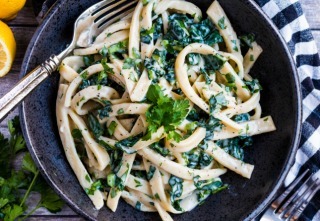 There’s such simplicity in pairing a delicious pasta sauce with zoodles or spaghetti squash, but sometimes you want to pull out all of the stops. When you feel like getting fancy, this Primal pasta is the perfect idea!
There’s such simplicity in pairing a delicious pasta sauce with zoodles or spaghetti squash, but sometimes you want to pull out all of the stops. When you feel like getting fancy, this Primal pasta is the perfect idea!
Since the Primal pasta recipe is not low-carb, we’ve also included a Keto option that is cheese based. Keep in mind that the Paleo recipe is a boiled pasta, while the Keto option is baked.
The recipes look a little involved, but the basic premise is: form dough, cut into pasta, and boil. If you’re following the Primal recipe, coconut milk and chopped kale is added to the pasta to provide more texture and body. If the Primal pasta dough seems to wet, add additional tapioca starch 1 teaspoon at a time. The Keto pasta recipe is actually baked, not boiled. Keto pasta should be formed into its desired shape prior to baking. It gets slightly dried out in the fridge and is then baked. Since the baked pasta is delicate, the coconut milk and kale can be omitted from the Keto version to keep the pasta from getting soggy.
Servings: 2
Prep Time: 25 minutes
Cook Time: 5 minutes
Ingredients:
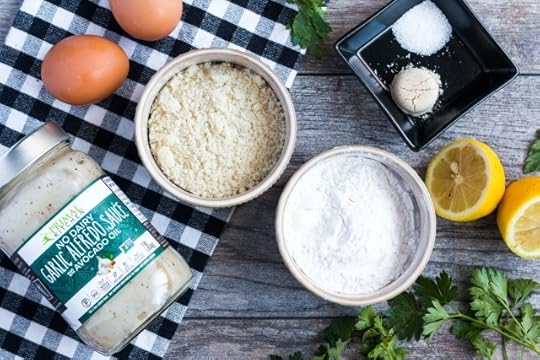
PALEO PASTA
Pasta:
½ cup Fine Almond Flour
½ cup + 2 Tbsp. Tapioca Starch
1 tsp. Coconut Flour
¼ tsp. Salt
1 Large Egg
1 Egg Yolk
Sauce:
2/3 cup Primal Kitchen® Garlic Alfredo Sauce
3/4 cup Chopped Lacinato Kale
2 Tbsp. Chopped Parsley
1 Tbsp. Coconut Milk
Pinch of Salt and Black Pepper
KETO PASTA
Keto Pasta:
1 cup Shredded Mozzarella (full fat, shredded ahead of time and refrigerated)
1 Egg Yolk
3/4 cup Almond Flour
1 tsp. Ground Chia Seeds
1/4 tsp. Apple Cider Vinegar
Pinch of Salt
Sauce:
2/3 cup Primal Kitchen Garlic Alfredo Sauce
2 Tbsp. Chopped Parsley
Pinch of Black Pepper
Paleo Pasta Instructions:

Combine the almond flour, ½ cup of tapioca starch, coconut flour and salt together in a bowl. Make a well in the center of the flour mixture and add in the eggs. Gently whisk the eggs together using a fork and as you whisk, slowly pull in the flour surrounding the egg in order to combine the egg and flour mixture. Allow the dough to rest for 2-3 minutes and mix in a tablespoon of tapioca starch. At this point, you should be able to knead the dough into a ball. Wrap the dough in plastic wrap and place it in the fridge for 30-45 minutes.
Fill a medium-sized pot about halfway with water (adding a pinch of salt), and set it over a medium heat burner.
Place a piece of parchment on a cutting board or your countertop. Dust the parchment with a bit of the remaining tapioca starch and put some on your hands as well. Unwrap the dough and place it on the parchment. Dust a little more on top of the dough and place another piece of parchment on top. Use a rolling pin or mallet to flatten out the dough into a flat rectangular shape, about 7 inches in width. The dough should be fairly thin, around 1/8 inch thick. Carefully cut the dough into thin strips of pasta with a knife or pizza cutter. Separate the strands and dust with any remaining tapioca starch.

Fill a medium-sized pot about halfway with water and set it over a burner over medium heat with a pinch of salt. Once the water is at a steady boil, drop about ¼ to 1/3 of the pasta into the water, one at a time to prevent the pasta from clumping together. The amount of time the pasta takes to cook will depend on how thick they are, but aim for 3-4 minutes. They are fairly hearty but will get mushy if you cook them for too long, so once they reach your desired doneness, carefully remove them from the pot and place them on a towel-covered plate. Repeat with the remaining pasta until it is all cooked.
Pour the lacinato kale into the pot of boiling water and cook until wilted. Strain the kale and set it aside.
Combine the Garlic Alfredo Sauce and coconut milk. Gently toss the pasta in the sauce mixture and add in the chopped kale and parsley. Garnish with a sprinkle of salt and pepper and parsley.
Keto Pasta Instructions:
Set up a double boiler on the stovetop and place a heat-safe bowl on top of the pot. Once the water is boiling, add the shredded mozzarella to the pot and gently agitate it with a spatula to encourage melting. Watch the cheese carefully and remove it from the heat once it is melted. Add in half of the almond flour and mix with a spoon of your hands. Mix in the egg yolk and apple cider vinegar. Once just combined, add in the remaining almond flour, the ground chia seeds and salt.
Knead the dough together into a ball and roll it out on a parchment-covered sheet pan. Since this pasta needs to be baked instead of boiled, you can be more creative when it comes to pasta shapes. This dough will hold together fairly well as spiraled pasta, bowties, or in a gnocchi shape. If you choose to make fettuccine shapes, give the pasta a bit of a wavy shape as you form it and place it back on the parchment. A great idea is to make fettuccine and then form the pasta into a spiral around your finger and place the spiral pasta on the sheet pan. Form the remaining dough into desired shapes and place the pan in the fridge for 1-2 hours.
Preheat your oven to 350 degrees Fahrenheit. Remove the dough from the fridge and place the pan in the oven. The amount of time the pasta takes to cook will depend on the size of the pasta shapes you make, but check them around 8 minutes. Once they are slightly golden, remove them from the oven. Allow the pasta to cool slightly, then gently toss the pasta into the Garlic Alfredo Sauce and top with chopped parsley and black pepper.

Paleo Pasta Alfredo Nutritional Information (½ of recipe):
Calories: 481
Total Carbs: 47 grams
Net Carbs: 43 grams
Fat: 27 grams
Protein: 13 grams
Keto Pasta Alfredo Nutritional Information (½ of recipe):
Calories: 480
Total Carbs: 11 grams
Net Carbs: 6 grams
Fat: 40 grams
Protein: 20 grams


The post Primal (or) Keto Pasta Alfredo appeared first on Mark's Daily Apple.



Mark Sisson's Blog
- Mark Sisson's profile
- 199 followers



